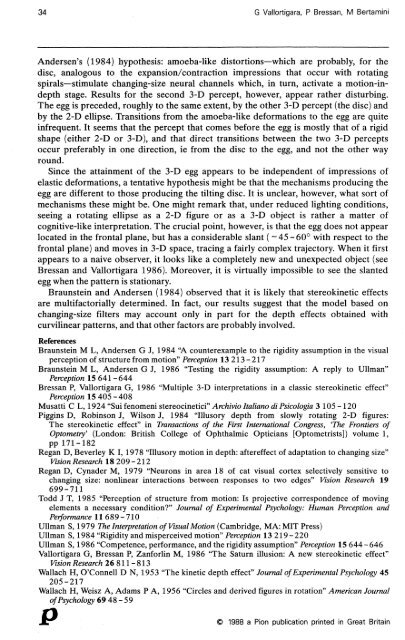Perceptual alternations in stereokinesis
Perceptual alternations in stereokinesis
Perceptual alternations in stereokinesis
You also want an ePaper? Increase the reach of your titles
YUMPU automatically turns print PDFs into web optimized ePapers that Google loves.
34 G Vallortigara, P Bressan, M Bertam<strong>in</strong>i<br />
Andersen's (1984) hypothesis: amoeba-like distortions—which are probably, for the<br />
disc, analogous to the expansion/contraction impressions that occur with rotat<strong>in</strong>g<br />
spirals—stimulate chang<strong>in</strong>g-size neural channels which, <strong>in</strong> turn, activate a motion-<strong>in</strong>depth<br />
stage. Results for the second 3-D percept, however, appear rather disturb<strong>in</strong>g.<br />
The egg is preceded, roughly to the same extent, by the other 3-D percept (the disc) and<br />
by the 2-D ellipse. Transitions from the amoeba-like deformations to the egg are quite<br />
<strong>in</strong>frequent. It seems that the percept that comes before the egg is mostly that of a rigid<br />
shape (either 2-D or 3-D), and that direct transitions between the two 3-D percepts<br />
occur preferably <strong>in</strong> one direction, ie from the disc to the egg, and not the other way<br />
round.<br />
S<strong>in</strong>ce the atta<strong>in</strong>ment of the 3-D egg appears to be <strong>in</strong>dependent of impressions of<br />
elastic deformations, a tentative hypothesis might be that the mechanisms produc<strong>in</strong>g the<br />
egg are different to those produc<strong>in</strong>g the tilt<strong>in</strong>g disc. It is unclear, however, what sort of<br />
mechanisms these might be. One might remark that, under reduced light<strong>in</strong>g conditions,<br />
see<strong>in</strong>g a rotat<strong>in</strong>g ellipse as a 2-D figure or as a 3-D object is rather a matter of<br />
cognitive-like <strong>in</strong>terpretation. The crucial po<strong>in</strong>t, however, is that the egg does not appear<br />
located <strong>in</strong> the frontal plane, but has a considerable slant ( ~45-60° with respect to the<br />
frontal plane) and moves <strong>in</strong> 3-D space, trac<strong>in</strong>g a fairly complex trajectory. When it first<br />
appears to a naive observer, it looks like a completely new and unexpected object (see<br />
Bressan and Vallortigara 1986). Moreover, it is virtually impossible to see the slanted<br />
egg when the pattern is stationary.<br />
Braunste<strong>in</strong> and Andersen (1984) observed that it is likely that stereok<strong>in</strong>etic effects<br />
are multifactorially determ<strong>in</strong>ed. In fact, our results suggest that the model based on<br />
chang<strong>in</strong>g-size filters may account only <strong>in</strong> part for the depth effects obta<strong>in</strong>ed with<br />
curvil<strong>in</strong>ear patterns, and that other factors are probably <strong>in</strong>volved.<br />
References<br />
Braunste<strong>in</strong> M L, Andersen G J, 1984 "A counterexample to the rigidity assumption <strong>in</strong> the visual<br />
perception of structure from motion" Perception 13213-217<br />
Braunste<strong>in</strong> M L, Andersen G J, 1986 "Test<strong>in</strong>g the rigidity assumption: A reply to Ullman"<br />
Perception 15641-6 44<br />
Bressan P, Vallortigara G, 1986 "Multiple 3-D <strong>in</strong>terpretations <strong>in</strong> a classic stereok<strong>in</strong>etic effect"<br />
Perception 15 405-408<br />
Musatti C L, 1924 "Sui fenomeni stereoc<strong>in</strong>etici" Archivio Italiano di Psicologia 3 105-120<br />
Pigg<strong>in</strong>s D, Rob<strong>in</strong>son J, Wilson J, 1984 "Illusory depth from slowly rotat<strong>in</strong>g 2-D figures:<br />
The stereok<strong>in</strong>etic effect" <strong>in</strong> Transactions of the First International Congress, 'The Frontiers of<br />
Optometry' (London: British College of Ophthalmic Opticians [Optometrists]) volume 1,<br />
pp 171-182<br />
Regan D, Beverley K I, 1978 "Illusory motion <strong>in</strong> depth: aftereffect of adaptation to chang<strong>in</strong>g size"<br />
Vision Research 18 209-212<br />
Regan D, Cynader M, 1979 "Neurons <strong>in</strong> area 18 of cat visual cortex selectively sensitive to<br />
chang<strong>in</strong>g size: nonl<strong>in</strong>ear <strong>in</strong>teractions between responses to two edges" Vision Research 19<br />
699-711<br />
Todd J T, 1985 "Perception of structure from motion: Is projective correspondence of mov<strong>in</strong>g<br />
elements a necessary condition?" Journal of Experimental Psychology: Human Perception and<br />
Performance 11 689-710<br />
Ullman S, 1979 The Interpretation of Visual Motion (Cambridge, MA: MIT Press)<br />
Ullman S, 1984 "Rigidity and misperceived motion" Perception 13 219-220<br />
Ullman S, 1986 "Competence, performance, and the rigidity assumption" Perception 15 644-646<br />
Vallortigara G, Bressan P, Zanforl<strong>in</strong> M, 1986 "The Saturn illusion: A new stereok<strong>in</strong>etic effect"<br />
Vision Research 26811-813<br />
Wallach H, O'Connell D N, 1953 "The k<strong>in</strong>etic depth effect" Journal of Experimental Psychology 45<br />
205-217<br />
Wallach H, Weisz A, Adams PA, 1956 "Circles and derived figures <strong>in</strong> rotation" American Journal<br />
of Psychology 69 48 - 59<br />
Jtr<br />
© 1988 a Pion publication pr<strong>in</strong>ted <strong>in</strong> Great Brita<strong>in</strong>
















